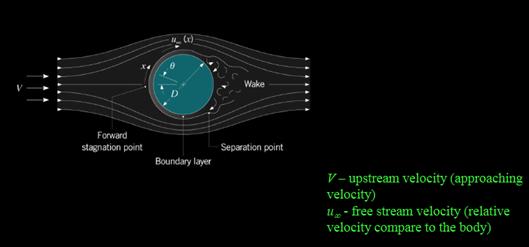
What is the difference between the upstream velocity and the free-stream velocity? For what types of flow are these two velocities equal to each other?
Difference between"Upstream flow velocity" and "free stream velocity"and for which flow are they equal.
Answer to Problem 1CP
Upstream velocity represents approaching velocity while free stream velocity represents velocity of fluid relative to the immersed body(solid).
They are equal in uniform flow.
The difference between upstream flow velocity and free stream velocity is given in table below:
| Upstream flow velocity | Free stream velocity |
| The velocity(V) at which any fluid flow approaches an immersed body is known as upstream flow velocity. | The sufficiently far away velocity of the fluid which is relative to the immersed body(solid) is the free stream velocity. It is denoted by |
| It is the actual velocity of fluid flowing just before approaching the immersed body | It is the velocity which exists at end of the velocity boundary layer around the immersed body. |

"Upstream flow velocity " and "free stream velocity" are same/equal when:
a. There is uniform fluid flow.
b. When the immersed body in fluid is relatively in comparison to uniform fluid flow rate, where it is immersed.
Explanation of Solution
The difference between upstream flow velocity and free stream velocity is given in table below:
| Upstream flow velocity | Free stream velocity |
| The velocity(V) at which any fluid flow approaches an immersed body is known as upstream flow velocity. | The sufficiently far away velocity of the fluid which is relative to the immersed body(solid) is the free stream velocity. It is denoted by |
| It is the actual velocity of fluid flowing just before approaching the immersed body | It is the velocity which exists at end of the velocity boundary layer around the immersed body. |

"Upstream flow velocity " and "free stream velocity" are same/equal when:
a. There is uniform fluid flow.
b. When the immersed body in fluid is relatively in comparison to uniform fluid flow rate, where it is immersed.
Want to see more full solutions like this?
Chapter 7 Solutions
HEAT & MASS TRANSFER (LL) W/CONNECT CARD
Additional Engineering Textbook Solutions
Mechanics of Materials (10th Edition)
Starting Out with C++ from Control Structures to Objects (9th Edition)
Automotive Technology: Principles, Diagnosis, And Service (6th Edition) (halderman Automotive Series)
SURVEY OF OPERATING SYSTEMS
Starting Out with Java: From Control Structures through Objects (7th Edition) (What's New in Computer Science)
Vector Mechanics For Engineers
- PROBLEM 3.46 The solid cylindrical rod BC of length L = 600 mm is attached to the rigid lever AB of length a = 380 mm and to the support at C. When a 500 N force P is applied at A, design specifications require that the displacement of A not exceed 25 mm when a 500 N force P is applied at A For the material indicated determine the required diameter of the rod. Aluminium: Tall = 65 MPa, G = 27 GPa. Aarrow_forwardFind the equivalent mass of the rocker arm assembly with respect to the x coordinate. k₁ mi m2 k₁arrow_forward2. Figure below shows a U-tube manometer open at both ends and containing a column of liquid mercury of length l and specific weight y. Considering a small displacement x of the manometer meniscus from its equilibrium position (or datum), determine the equivalent spring constant associated with the restoring force. Datum Area, Aarrow_forward
- 1. The consequences of a head-on collision of two automobiles can be studied by considering the impact of the automobile on a barrier, as shown in figure below. Construct a mathematical model (i.e., draw the diagram) by considering the masses of the automobile body, engine, transmission, and suspension and the elasticity of the bumpers, radiator, sheet metal body, driveline, and engine mounts.arrow_forward3.) 15.40 – Collar B moves up at constant velocity vB = 1.5 m/s. Rod AB has length = 1.2 m. The incline is at angle = 25°. Compute an expression for the angular velocity of rod AB, ė and the velocity of end A of the rod (✓✓) as a function of v₂,1,0,0. Then compute numerical answers for ȧ & y_ with 0 = 50°.arrow_forward2.) 15.12 The assembly shown consists of the straight rod ABC which passes through and is welded to the grectangular plate DEFH. The assembly rotates about the axis AC with a constant angular velocity of 9 rad/s. Knowing that the motion when viewed from C is counterclockwise, determine the velocity and acceleration of corner F.arrow_forward
 Elements Of ElectromagneticsMechanical EngineeringISBN:9780190698614Author:Sadiku, Matthew N. O.Publisher:Oxford University Press
Elements Of ElectromagneticsMechanical EngineeringISBN:9780190698614Author:Sadiku, Matthew N. O.Publisher:Oxford University Press Mechanics of Materials (10th Edition)Mechanical EngineeringISBN:9780134319650Author:Russell C. HibbelerPublisher:PEARSON
Mechanics of Materials (10th Edition)Mechanical EngineeringISBN:9780134319650Author:Russell C. HibbelerPublisher:PEARSON Thermodynamics: An Engineering ApproachMechanical EngineeringISBN:9781259822674Author:Yunus A. Cengel Dr., Michael A. BolesPublisher:McGraw-Hill Education
Thermodynamics: An Engineering ApproachMechanical EngineeringISBN:9781259822674Author:Yunus A. Cengel Dr., Michael A. BolesPublisher:McGraw-Hill Education Control Systems EngineeringMechanical EngineeringISBN:9781118170519Author:Norman S. NisePublisher:WILEY
Control Systems EngineeringMechanical EngineeringISBN:9781118170519Author:Norman S. NisePublisher:WILEY Mechanics of Materials (MindTap Course List)Mechanical EngineeringISBN:9781337093347Author:Barry J. Goodno, James M. GerePublisher:Cengage Learning
Mechanics of Materials (MindTap Course List)Mechanical EngineeringISBN:9781337093347Author:Barry J. Goodno, James M. GerePublisher:Cengage Learning Engineering Mechanics: StaticsMechanical EngineeringISBN:9781118807330Author:James L. Meriam, L. G. Kraige, J. N. BoltonPublisher:WILEY
Engineering Mechanics: StaticsMechanical EngineeringISBN:9781118807330Author:James L. Meriam, L. G. Kraige, J. N. BoltonPublisher:WILEY





